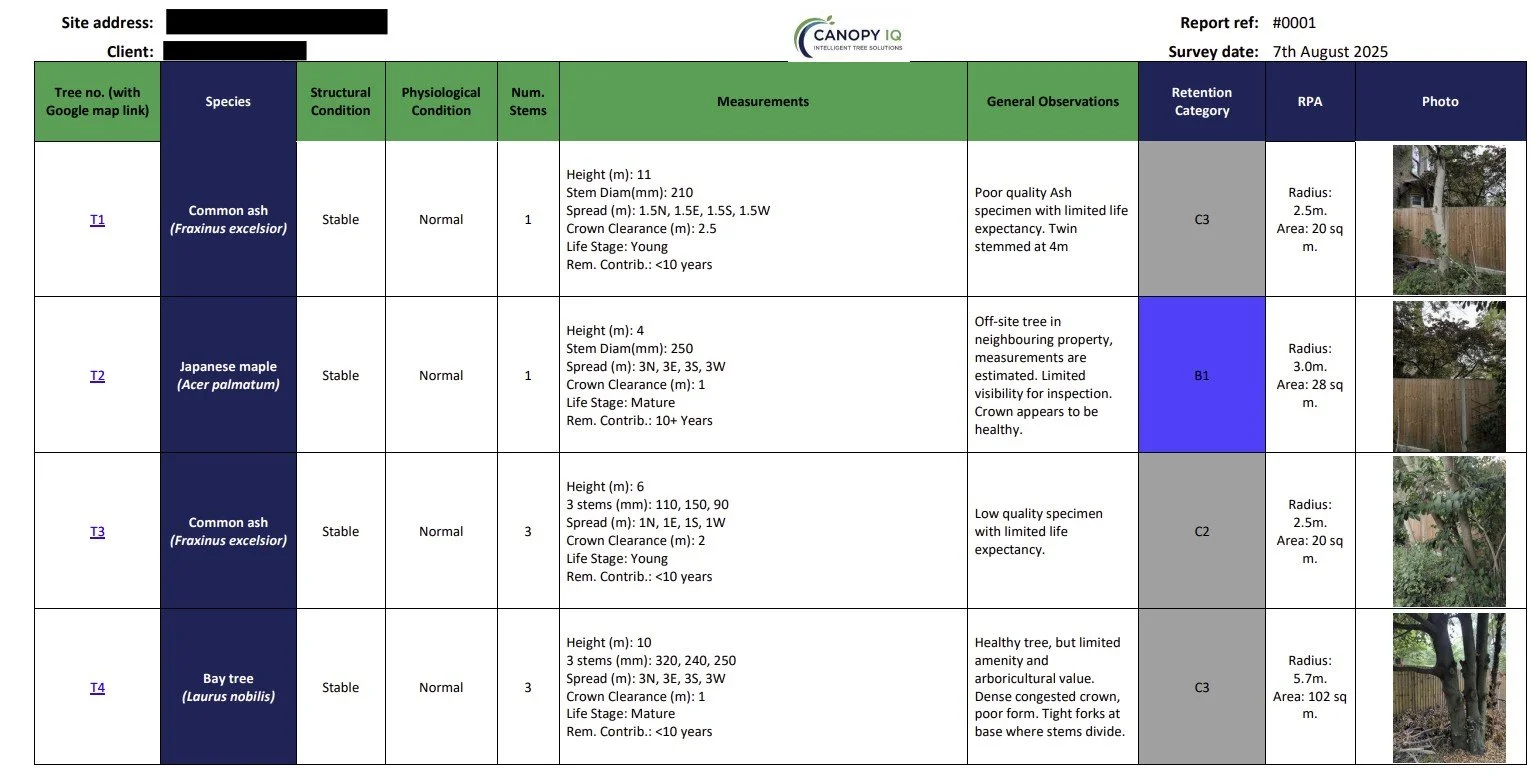
BS 5837 Reports for Planning Applications
Intelligent Tree Solutions
Our Three-Stage BS 5837 Survey Process
At Canopy IQ, we provide a structured approach to support your development from concept to completion. Each stage is meticulously designed to simplify the planning process, ensure full compliance with British Standard 5837:2012, and facilitate the sustainable integration of trees into your project.

Stage 1: Tree Survey, Constraints Report & Plan – Pre-Application Stage
This foundational stage is critical for informing initial site feasibility and layout design, producing a working document that, while not required by the local authority, allows architects and developers to plan around potential conflicts from the very beginning.
Detailed Site Survey: Our process begins with a comprehensive on-site tree survey, undertaken in accordance with BS 5837:2012. We methodically record the species, dimensions, age, and physiological / structural condition of each tree.
Tree Categorisation: Each tree is assessed and assigned a retention value, categorising it based on its quality and life expectancy. This data is essential for understanding which trees should be prioritised for retention.
Tree Constraints Report (TCR): Alongside the survey, we prepare a detailed Tree Constraints Report containing a full schedule of tree data, relevant site features, and any applicable TPOs. The TCR guides design and is not a formal LPA requirement.
Tree Constraints Plan (TCP): We produce a precise AutoCAD plan illustrating each tree’s location, canopy spread, and Root Protection Area (RPA) – the essential below-ground constraint zone to be safeguarded.

Example Tree Survey Schedule (Data Sheet)
Stage 2: Arboricultural Impact Assessment (AIA) – Planning Application Submission
Once a design proposal has been developed, this stage provides a robust evaluation of its effect on the site’s existing trees. The AIA is often required for planning validation and demonstrates to the Local Planning Authority that tree impacts have been fully considered.
Impact Evaluation: We assess how the proposed layout interacts with retained trees, identifying direct or indirect impacts such as RPA incursions, shading, or dominance.
Mitigation & Justification: Where conflicts are identified, we propose practical mitigation strategies or design modifications to protect valuable trees.
Supporting Planning Document: The final AIA provides reasoned justification for removals and retention viability, evidencing compliance with BS 5837:2012 and a responsible approach to tree stewardship.
Stage 3: Arboricultural Method Statement (AMS) & Tree Protection Plan (TPP) – Post-Approval / Pre-Commencement
Following planning consent, this final stage translates approved plans into practical on-site instructions for construction, creating the Method Statement required to discharge conditions and ensure long-term tree protection.
Arboricultural Method Statement (AMS): Local Authorities frequently require an AMS as a planning condition. We prepare a detailed, site-specific statement specifying protection barriers, ground protection, and sequencing of tree works.
Tree Protection Plan (TPP): Accompanying the AMS, the TPP is an updated AutoCAD plan showing all fencing and ground protection specifications, giving contractors clear instructions to implement safeguards consistently on site.

Example Tree Protection Plan (Construction Phase)
Canopy IQ delivers clear, professional, and easy-to-understand reports. We pride ourselves on offering intelligent, site-specific solutions tailored for homeowners, developers, architects, and planning consultants. Our goal is to ensure full compliance, protect valuable trees, and contribute to the seamless progression of your project.
What Our Customers Say
"We required a Tree Survey/Arboricultural Statement which needed to include Tree Protection Plan for planning purposes and found Canopy IQ Ltd online. From first contact the service was extremely prompt, honest, and professional. Site visit and report was completed within a few days, the report was thorough and clear, aided us and local authority to attain the planning permission we required. Thank you. We would highly recommend Canopy IQ Ltd."
"Excellent communications and willingness to deal with an issue at short notice. Very helpful and prompt service giving me exactly what I needed at a decent price."
"Professional, Reliable, Efficient. We contacted Ian a few days ago as we were in the process of applying for planning permission and needed an updated AIA. Ian was extremely professional, efficient, and helpful throughout. He completed everything within a couple of days, and we were able to rely on him completely. The whole process went smoothly, and we can’t thank him enough for his support. He’s a true professional whom we fully trust, and we would highly recommend him and will definitely contact him again for future projects. – Eyre Garden Design"
"We required a Tree Protection Plan for planning purposes and found Canopy IQ Ltd online. From the moment we contacted them, the service was extremely prompt, honest, and professional. Ian responded to our emails and phone calls within hours, and he completed the entire TPP within a week. The report was clear, thorough, and delivered quickly. We would highly recommend Canopy IQ Ltd."
Contact Us
Contact Canopy IQ today for intelligent tree solutions and expert arboricultural advice across Kent, East London, South East London, and beyond.
Whether you need a tree condition survey to ensure the health and safety of your trees or a professional BS5837:2012 tree survey to help your development project move forward smoothly, our experienced team is here to help. We provide clear, actionable insights for homeowners, developers, architects, and landowners.
Get in touch now for a no-obligation discussion or to request a quote.
